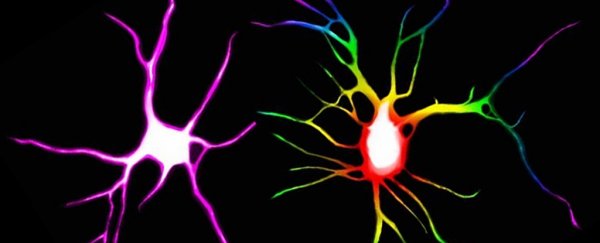Could psychedelic drugs one day play a part in the treatment of mental health conditions? The idea is getting less and less far-fetched, after scientists successfully used drugs including MDMA and LSD to repair neurons in animal tests and cultured cells.
In small microdoses tested on rats, flies, and zebrafish, the substances sparked new growth in neurites, the bridges between neurons that enable internal communications.
With previous research suggesting that neurites in the prefrontal cortex can retract and shrivel when conditions like depression take hold, being able to reverse the process could open up a crucial new avenue for finding effective treatments.
"These are some of the most powerful compounds known to affect brain function," says senior researcher David E. Olson, from the University of California, Davis. "It's very obvious to me that we should understand how they work."
The new study was partly prompted by the increasingly encouraging research that shows ketamine as a way to counteract depression. The drug has been shown to ease suicidal thoughts in hours, and the scientists behind the latest research were keen to see if other hallucinogens might have similar effects on the brain.
They worked through a series of tests in both cultured cells and living animals, covering a variety of mind-altering drugs and different doses in rats, Drosophila (fruit flies), and zebrafish.
While the results varied across tests, across the study as a whole the psychedelics were shown to increase the number of dendrites, or branches between cells, as well as increasing the density of dendritic spines and synapses. These structures all play important roles in the brain's communication channels.
Even better, in some cases the 'rewiring' of the brain lasted longer than the effects of the drugs would normally be expected to.
 The effects of drugs and one control (VEH) on neurons. (Ly et al., CC BY-ND)
The effects of drugs and one control (VEH) on neurons. (Ly et al., CC BY-ND)
"People have long assumed that psychedelics are capable of altering neuronal structure, but this is the first study that clearly and unambiguously supports that hypothesis," says Olson.
"What is really exciting is that psychedelics seem to mirror the effects produced by ketamine."
No human cells were included in the tests, but the fact that neurons from multiple species were put under the microscope, and that the team was able to explain the genetic pathway of the mechanism both suggest this might work on human brains as well.
That's still some way off, but the researchers are planning to investigate whether these psychedelic drugs could be used to improve the plasticity of the brain – its ability to repair itself – without the associated hallucinations or other side effects.
This is going to need closer examination of how these substances affect the brain, and in particular which biological pathways they switch on, and which proteins they produce.
Before we can create compounds suitable for treatment, the researchers say, we need to make sure they're not having adverse effects on neural networks as well as positive ones.
Another unknown is how psychedelic drugs like these might work on older brains.
"Our work demonstrates that there are a number of distinct chemical scaffolds capable of promoting plasticity like ketamine," says Olson, adding that this could help us develop safe and effective alternatives.
The research has been published in Cell Reports.
